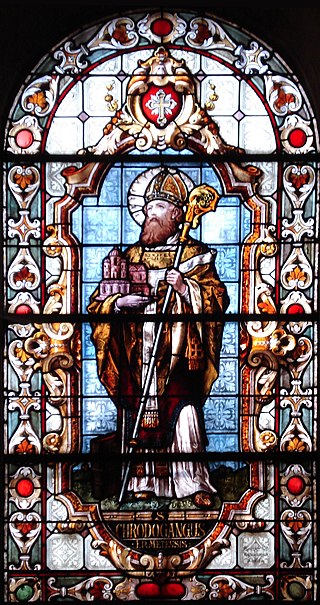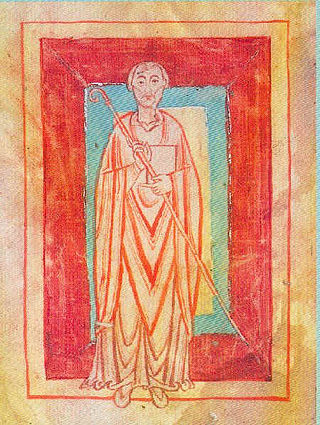
Gorze Abbey was a Benedictine monastery in Gorze in the present arrondissement of Metz, near Metz in Lorraine. It was prominent as the source of a monastic reform movement in the 930s. [1]

Gorze Abbey was a Benedictine monastery in Gorze in the present arrondissement of Metz, near Metz in Lorraine. It was prominent as the source of a monastic reform movement in the 930s. [1]
Gorze Abbey was founded in around 757 [2] by Bishop Chrodegang of Metz, [3] who obtained for it from Rome the relics of Saint Gorgonius. The new community at first followed his Rule, but decline later set in. The highly placed Frankish lord Bivin of Gorze (810–863), married to a daughter of Boso the Elder, functioned as lay abbot of Gorze. [4] In 933 the premises, by then semi-derelict, were given by Adalbero, Bishop of Metz, to John of Gorze and Einald of Toul so that they could restore observance of the Rule of St. Benedict. [5] They did so extremely successfully and the customary of Gorze soon spread to many other monasteries, [6] at first local, such as St. Maximin's Abbey, Trier, and St. Evre's Abbey, Toul, and later in more distant places, such as Bavaria, through the mediation of Wolfgang of Regensburg.
The Gorze Reform was similar to the Cluniac Reform in that it aimed at a reestablishment of the Rule of St. Benedict, but quite different in several major areas. In particular, whereas Cluny created a centralised system of authority in which the religious houses adopting its reforms became subordinate to Cluny itself, the Gorze reforms preserved the independence of the participating monasteries, and resulted instead in a network of loosely connected affiliations based on several centres, such as Fulda, Niederaltaich, Einsiedeln and St. Emmeram's Abbey in Regensburg. [7]
Gorze was also the home of the "chant messin", an early form of Gregorian chant or plainsong, as a part of the liturgy, and also of sacred drama, particularly in connection with the Easter rituals.
From the 12th century Gorze ceased to occupy the central spiritual position it had had previously. Nevertheless, in material terms it continued to prosper, and in the 12th and 13th centuries undertook substantial building works, including the lay church, which alone of the abbey buildings still survives, as the present parish church of Saint Stephen.

The extensive territory which the abbey accumulated became known as the "Terre de Gorze". The abbey was dissolved in 1572 as a consequence of the Reformation. An attempt at a re-foundation in 1580 came to nothing, and the buildings, apart from St. Stephen's church, were demolished.
The "Terre de Gorze" continued however as a territorial unit, with an abbot as its overlord, even in the absence of a monastic community. In the 1660s these lands passed from the Holy Roman Empire to France. In the 1690s, the Prince-Abbot Eberhard von Löwenstein built an appropriately splendid residence, which still stands. At the time of the French Revolution the building was confiscated and sold off and was later used for a variety of military and local government purposes, particularly as a workhouse for the poor. The palace has now been restored and is in use as a museum, old people's home and for several other purposes. The gardens, nymphaeum and chapel are all of architectural and artistic interest.
The abbey is the property of the commune. It has been listed since 1886 as a monument historique by the French Ministry of Culture. [8]

The Benedictines, officially the Order of Saint Benedict, are a mainly contemplative monastic order of the Catholic Church for men and for women who follow the Rule of Saint Benedict. Initiated in 529 they are the oldest of all the religious orders in the Latin Church. The male religious are also sometimes called the Black Monks, especially in English speaking countries, after the colour of their habits. Not all Benedictines wear black, however, with some like the Olivetans wearing white. They were founded by Benedict of Nursia, a 6th-century Italian monk who laid the foundations of Benedictine monasticism through the formulation of his Rule. Benedict's sister, Scholastica, possibly his twin, also became a religious from an early age, but chose to live as a hermit. They retained a close relationship until her death.

Lay abbot is a name used to designate a layman on whom a king or someone in authority bestowed an abbey as a reward for services rendered; he had charge of the estate belonging to it, and was entitled to part of the income. The custom existed principally in the Frankish Empire from the eighth century until the ecclesiastical reforms of the eleventh.

Lorsch Abbey, otherwise the Imperial Abbey of Lorsch, is a former Imperial abbey in Lorsch, Germany, about 10 km (6.2 mi) east of Worms. It was one of the most important monasteries of the Carolingian Empire. Even in its ruined state, its remains are among the most important pre-Romanesque–Carolingian style buildings in Germany.

Chrodegang was the Frankish Bishop of Metz from 742 or 748 until his death. He served as chancellor for his kinsman, Charles Martel. Chrodegang is claimed to be a progenitor of the Frankish dynasty of the Robertians. He is recognized as a saint in the Catholic Church.

Cluny Abbey is a former Benedictine monastery in Cluny, Saône-et-Loire, France. It was dedicated to Saints Peter and Paul.
The Cluniac Reforms were a series of changes within medieval monasticism in the Western Church focused on restoring the traditional monastic life, encouraging art, and caring for the poor. The movement began within the Benedictine order at Cluny Abbey, founded in 910 by William I, Duke of Aquitaine (875–918). The reforms were largely carried out by Saint Odo and spread throughout France, into England, and through much of Italy, northern Portugal and Spain.

William of Hirsau was a Benedictine abbot and monastic reformer. He was abbot of Hirsau Abbey, for whom he created the Constitutiones Hirsaugienses, based on the uses of Cluny, and was the father of the Hirsau Reforms, which influenced many Benedictine monasteries in Germany. He supported the papacy in the Investiture Controversy. In the Roman Catholic Church, he is a Blessed, the second of three steps toward recognition as a saint.

Saint Emmeram's Abbey was a Benedictine monastery founded around 739 at Regensburg in Bavaria at the grave of the itinerant Frankish bishop Saint Emmeram. The original abbey church is now a parish church named St. Emmeram's Basilica. The other buildings on the site form a large complex known as Schloss Thurn und Taxis or Schloss St. Emmeram, which has served as the main residence of the Thurn und Taxis princely family since the early 19th century.
Münsterschwarzach Abbey, is a monastery for Benedictine monks in Germany. It is located at the confluence of the rivers Schwarzach and Main in Bavaria.

Fleury Abbey (Floriacum) in Saint-Benoît-sur-Loire, Loiret, France, founded in about 640, is one of the most celebrated Benedictine monasteries of Western Europe, and possesses the relics of St. Benedict of Nursia. Its site on the banks of the Loire has always made it easily accessible from Orléans, a center of culture unbroken since Roman times. In 2010, the abbey had over forty monks led by the abbot Etienne Ricaud.

Carolingian architecture is the style of north European Pre-Romanesque architecture belonging to the period of the Carolingian Renaissance of the late 8th and 9th centuries, when the Carolingian dynasty dominated west European politics. It was a conscious attempt to emulate Roman architecture and to that end it borrowed heavily from Early Christian and Byzantine architecture, though there are nonetheless innovations of its own, resulting in a unique character.

The Abbey of St Vaast was a Benedictine monastery situated in Arras, département of Pas-de-Calais, France.
Saint John of Gorze was a Lorraine-born monk, diplomat, administrator, and monastic reformer.

The Abbey of Montier-en-Der in Haute-Marne, France, was formerly a Benedictine, later Cluniac, abbey, dissolved during the French Revolution, the grounds and premises of which, since 1806, have been used as the French National Stud Farm.
The Abbey of St. Evre was a Benedictine, later Cluniac, monastery in Toul, France. Established in or just before 507, it was the oldest monastery in Lorraine and of great significance in the monastic and religious reforms in the Rhine and Moselle region of the 10th and 11th centuries.

Adalbero I was the bishop of Metz from 929 till 954.

The Abbey of St. Vincent, Laon was a Benedictine monastery in Laon, Picardy, northern France.

The Ancient Abbey of Canons Regular of St. Augustine of Saint-Pierremont is a former Augustinian abbey in the commune of Avril in what is now the Meurthe-et-Moselle département of France, founded in the late eleventh century and dedicated to Saint Peter. Little is left of the medieval abbey buildings. Some buildings of the eighteenth century survive, notably the dovecote of the abbey, which was built in 1747 in the Baroque style and remodeled in 1774 with Rococo elements; it is registered in the Base Mérimée of notable French architectural monuments.
Adalbero II of Metz was a Catholic bishop of the 10th and 11th centuries. From 984 until his death he was the bishop of Verdun and bishop of Metz. He was the son of Frederick I, Duke of Upper Lorraine and Beatrice of France, daughter of Hugh the Great.

The Abbey of Saint-Symphorien or St Symphorian's Abbey is a former Benedictine monastery founded by Saint Papoul, bishop of Metz, in 609. It was the first Benedictine abbey for men built in Austrasia.